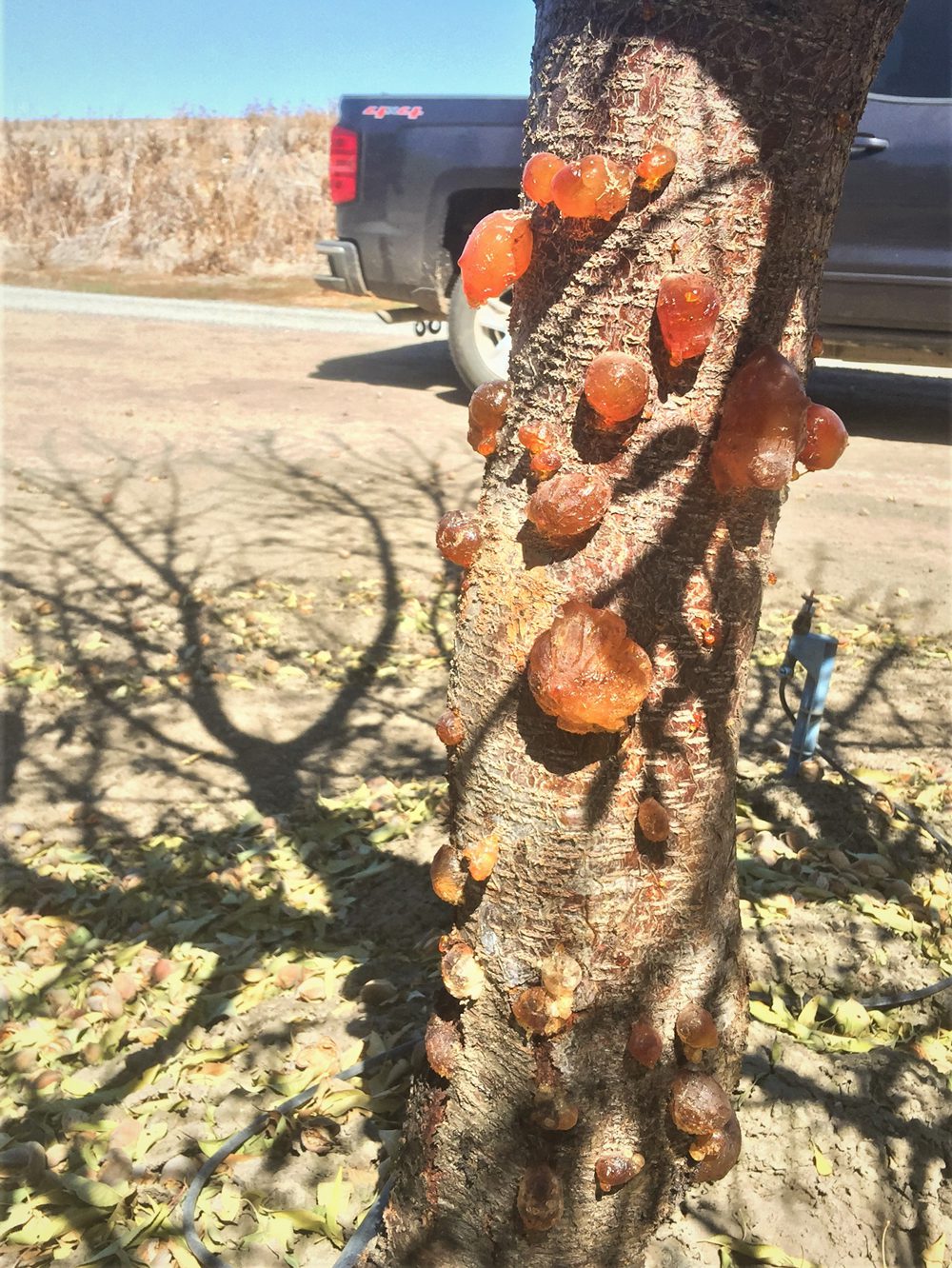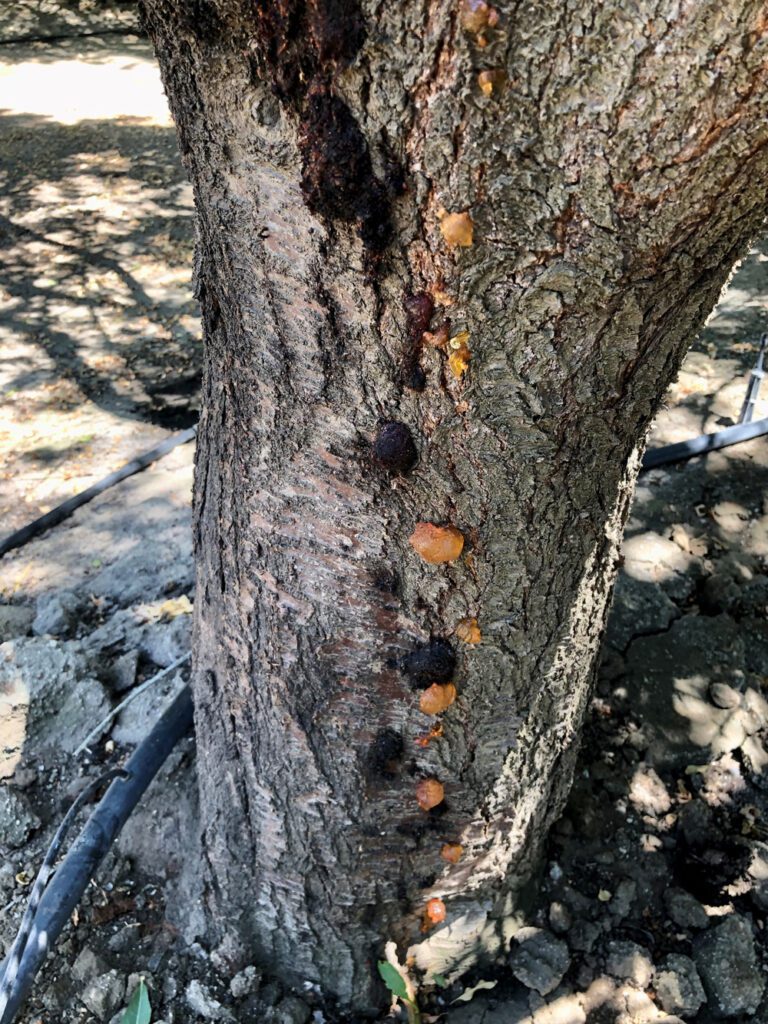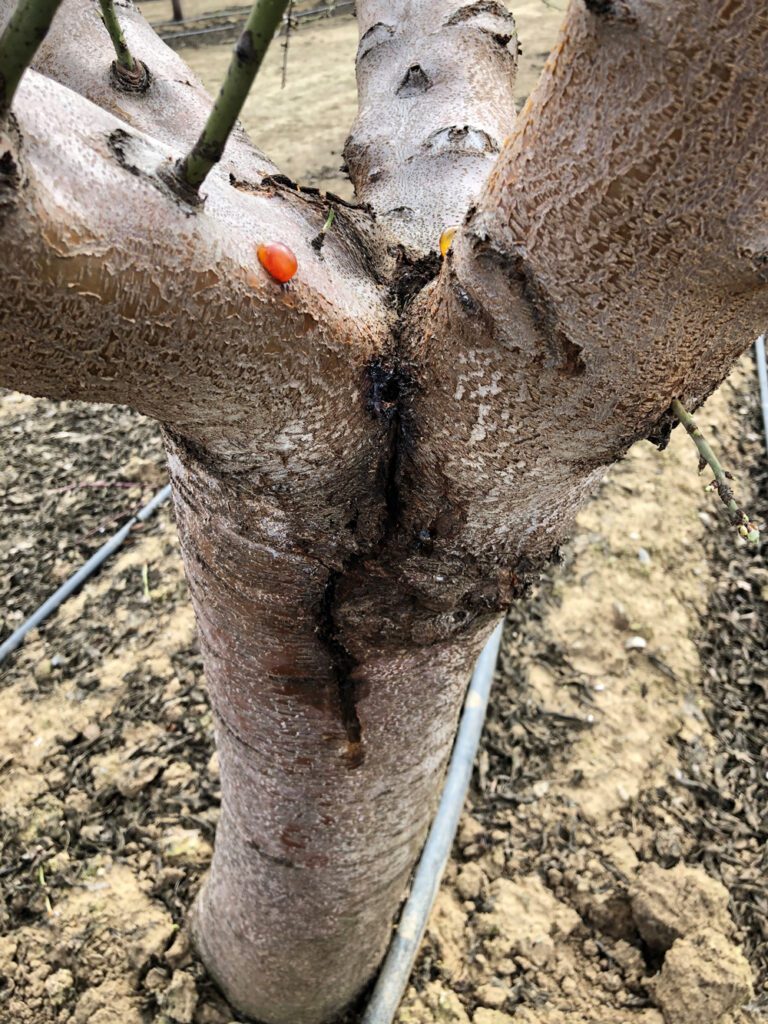
With 26 fungal species associated with canker disease, it is important for growers and farm managers to determine which pathogen is attacking their almond trees. Field diagnosis plus a laboratory test can reveal the responsible pathogen or point to an abiotic reason for canker formation.
Florent Trouillas, UCCE plant pathology specialist at the Kearney Agriculture Research and Education Center, noted during a presentation at The Almond Conference that in order to use the most effective control options, it is critical to understand which diseases can affect the trunks and scaffolds of almond trees. UCCE Plant Pathologist Themis Michailides and USDA researcher Greg Browne also provided information on control and prevention of canker diseases.
Causes and Diagnoses
Most infections of fungal canker diseases occur at pruning wounds made for primary and secondary scaffold selection. Fungal pathogens that cause gumming and dieback in almond trees are the leading cause of death in young orchards, Trouillas noted. These pathogens include Botryosphaeria, Ceratocystis, Diaporthe, Eutypa and Phytophthora.

Botryosphaeria is associated with band cankers that infect cracks in the bark and pruning wounds. These cankers often present in a row around the trunk. Two- to five-year-old trees with vigorous cultivars are most affected by this disease.
Phytophthora and Ceratocystis infections also cause gumming on the tree trunk and scaffold branches. Ceratocystis cankers are more elongated and are common in prune and cherry trees. The pathogen is transmitted by insects and affects both young and old trees.
Phytophthora infections are notable for their quick development as well as gumming of the trunk and scaffolds.
Eutypa infections begin in pruning wounds or in cracks near the tree crotch.
There are also abiotic reasons for trees to develop cankers. Those include herbicide injury, acid burn and boron toxicity. Foamy canker, marked by copious amounts of reddish gum that flows from the cankers, can be caused by a number of abiotic stressors.
Location on the tree and infection sites can help with a field diagnosis, but Trouillas said a molecular diagnosis is a tool that can now be made in 24 hours using a species-specific primer that targets all canker pathogens.
Prevention and Control Measures
Trouillas said there are no cures for fungal canker diseases, but preventative measures can be taken to reduce chances of infection.
Preventing disease establishment during the first few years after planting can be done by protecting pruning wounds following scaffold selection.
Recent pruning wound treatment trials tested efficacy of fungicides, pastes, sealants, paint and biocontrol agents.
Trouillas said the biocontrol agent Trichoderma, marketed as Vintec, had some of the lowest fungal recovery rates in the trial. These antagonistic fungi product is now registered for use in California. Topsin fungicide had similar efficacy. He noted that after pruning, there is a two-week window where protective treatments have optimal effect.

Michailides noted that band canker in almonds has been on the rise since 2005 and has the potential to kill trees. Bands of cankers develop in a circular pattern around the tree trunk. In severe cases, two to three bands may be present.
Preventative measures in young orchards involve obtaining clean trees from nurseries. Once planted, the fungicide Topsin-M should be applied to the trunks at label rates during the first-, second- and third-leaf years. Avoiding wetting tree trunks during irrigation and protecting pruning wounds with Topsin at label rates is advised.
When band canker is present in young orchards, it is recommended to keep tree trunks dry, apply Topsin-M to trunks and scaffolds and to also protect pruning wounds. Killed trees and stumps should be removed from the orchard and wood piles should not be located near orchard sites to lower inoculum levels.
Best management of perennial Phytophthora Canker (PCC) and Phytophthora crown and root rots (PCRR) involves integrated cultural, genetic and chemical control.
Phytophthora, a ‘water mold,’ is adapted to being spread by surface water and reaching plant roots, persisting in adverse conditions.
Disease Trends
Browne said that PCC, which mostly results from scion infections, is most prevalent in mature orchards, while PCRR results mostly from rootstock infections and is most prevalent in young orchards.
He noted trends and factors that are contributing to these diseases in California almonds.
- A shift from Nemaguard to Hansen 536 rootstock in much of the San Joaquin Valley
- Continuing infestation of some nursery stock with Phytopthora
- Shifts and movement of California populations of Phytopthora
- Suboptimal placement of drip and microsprinkler emitters
- Tree training that results in vulnerable trunk and scaffold junctures
- Introduction of Phytopthora to orchard soils via surface water or other sources
- Storm systems conducive to scion infection by Phytophthora
Browne said PCC can be spread to trees via dust generated by harvest activity. The pathogen can also move via Phytophthora-infested debris that accumulates in tree crotches and bark cracks during water saturation with conducive temperatures. Different species are prevalent at different infection sites. P. citricola is prevalent in cankers that originate above ground while P. cactorum is prevalent in cankers that originate below the soil line.
Cultural controls for PCC include avoiding susceptible rootstocks, not burying the graft union and avoiding ‘water pockets’ by training trees for vertical spread between points of scaffold attachment on trunks.
Chemical approaches include a summer-fall phosphite foliar spray as they are more effective than chemigation. There are phosphite residue limits, Browne warned. New chemistries are in the testing phase, but registrations will initially be for soil applications.










